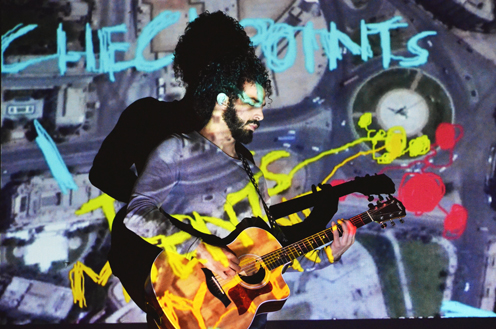Theater: Staring Fear in the Face: Documentary Art and Mortality
By Justine Bayond Espoz
arttimesjournal October 31, 2017
 Ramy |
As days get shorter and nights get colder, we approach the spookiest time of the year, reveling in yet another cycle of death that will inevitably lead to rebirth in the spring. We celebrate ghosts and ghouls and all things associated with the finality of life and that which may linger after. It’s both terrifying and intriguing. We find solace in facing that greatest of fears - our own mortality – and enjoy the thrill of looking it in the eye.
Social and political unrest seems to have loomed heavy over the past few years. With the refugee crisis, increasing terrorist attacks and now even the threat of nuclear war, we seem to be staring death in the face daily, and as a result, artists seem more inclined than ever to use their work to address it. Through a long cathartic process, artists confront the people and situations that have forced them to challenge their mortality and physical and emotional fragility. Those of us, frightened to no small degree by the inhumanity of political regimes and exploitation of fear and demagoguery, follow these artists on their journey, bracing ourselves for that moment when their pain and loss transcends the stage and shapes our own experience.
I had some idea of what I was in for as I filed into the first row of the Red Lecture Theater at Summerhall in Edinburgh, Scotland to see Ramy – In the Frontline, an autobiographical one-man show by Egyptian songwriter Ramy Essam and produced by Finnish company Viirus Theatre. The piece is Ramy’s account of how and why he joined the Arab Spring in 2011, ultimately becoming one of the faces of the Egyptian revolution by performing his politically-charged music, protesting and fighting in Cairo’s Tahrir Square.
I’d been in that very square just two weeks before the revolution erupted, learning from Egyptians and expats about the devastatingly repressive Mubarak regime. The authoritative omnipresence of the machine gun-clad military in the capital city made evident that this was a police state in which fear, intimidation and violence reigned supreme. I watched the revolution unfold on the TV screen from the safety of a comfortable apartment in Europe, biting my nails and hoping that the protesters - those Egyptians who chose to confront their fear head on - would be successful. For if there was ever a country in need of a revolution, it was Egypt.
I watched the revolution surge and ultimately fizzle, as a new military regime came to power and Egypt stopped receiving international news coverage. It had been many years since I’d last contemplated the state of Egypt, but Ramy Essam, a political exile now residing in Sweden, was giving me the opportunity to revisit a place and time that had impacted me greatly.
I knew walking into that lecture room that although the production was couched within the framework of a performing arts festival, it would not be entertaining, that it might even be tremendously uncomfortable, but I went anyway, ready to follow Ramy down a rabbit hole of human loss and anguish. For better or worse, it was not a typical night at the theater.
Combining storytelling, video and live music, Ramy sets the scene with stories of his youth as a somewhat misguided and mildly thuggish misanthrope growing up in a country where corruption is commonplace. His dalliance with street violence later becomes a key factor in his survival during clashes with the police and government-backed mercenaries in Tahrir Square. He talks about a sociopolitical awakening at the hands of his feminist sister and a politically minded poet, details that lend themselves to a still somewhat palatable coming-of-age story. But when talk turns to Egypt and the abuses of a corrupt police force, whimsy turns to abject horror.
How to drive home to a Western audience the fear, repression and physical aggression that Egyptians faced daily and that ultimately became so unbearable that it exploded into a popular overthrow of a dictator? The answer depends on the artist, and Ramy decided on journalistic realism. In what is one of the most uncomfortable moments of the performance, brief clips of torture filmed by police on their cell phones are projected. I had to physically cover my eyes to try to block it out. A gasp of horror escaped my lips as an image of activist Khaled Said’s mangled face appeared on screen. It was an image I’d seen before and hoped I’d never have to see again. Khaled’s torture and murder at the hands of police was the spark that lit the fuse of revolution. Ramy had made his point without barely having to speak a word.
He goes on to tell of his trip to Cairo to protest in the square, the assassination of his friend during attacks on protestors and his subsequent arrest and torture. The stories are vivid and blistering, a true life tale so raw that it’s difficult to pick out the artistry. “What about this compendium of recounted experiences makes it a work of theatre?”, I felt compelled to ask myself as I walked out shaken and crestfallen.
Is the mere act of weaving together thoughts and memories into a public work enough to make it art? One cannot argue that something new and ephemeral was created and performed. Maybe it’s the fact that the audience willingly came to hear a story that makes it art, or the fact that said story elicited a visceral reaction without requiring that we experience the situations described firsthand. From behind the fourth wall, we stared at the goblins and ghosts, we witnessed human frailty, remembered those lost, and awaited the cycle of death and rebirth, ultimately leaving us unscathed but not unchanged. Is that not the goal of great art?
